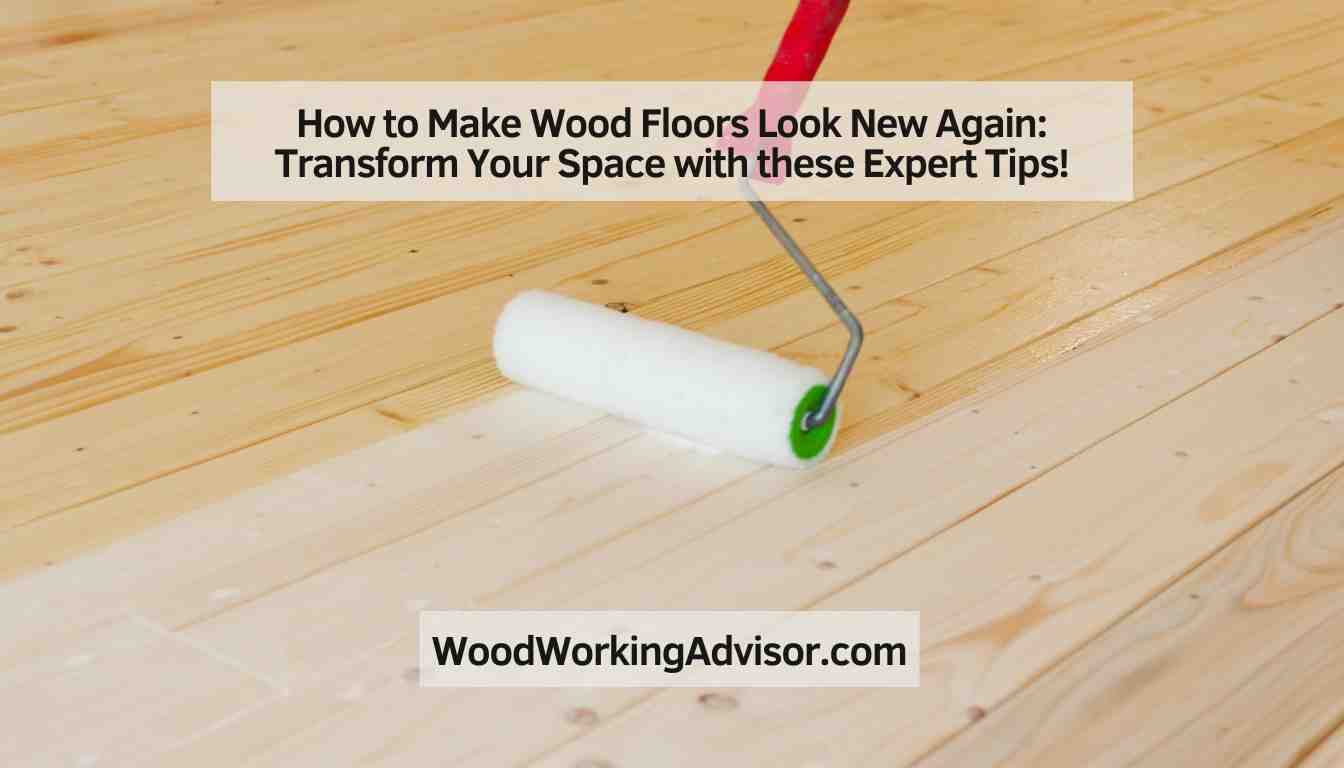To make wood floors look new again, start by cleaning them thoroughly and sanding away any imperfections. Apply a fresh coat of finish for a shiny and revitalized appearance.
Welcome the natural warmth and beauty of your wood floors back to life with a simple rejuvenation process. Over time, wear and tear can dull the luster of these timeless surfaces. But fear not, with just a little effort, you can restore your wood floors to their former glory.
By following some easy steps and using the right materials, you can achieve a fresh and vibrant look for your wood floors. Say goodbye to scratches, scuffs, and dullness as you embark on this journey to revive your living space with polished and gleaming wood floors.
Assessment Of The Current Condition
- Look for scratches, gouges, or water stains.
- Check for any warping or buckling of the wood.
- Examine for termite or mold infestations.
- Assess the level of dullness or discoloration.
- Measure the depth of scratches or scuff marks.
- Determine the overall condition of the finish.
Cleaning And Preparing The Surface
To make wood floors look new again, proper cleaning and preparation are crucial.
Removing Old Finishes
- Start by inspecting the floor for any existing finishes that need to be removed.
- Use a gentle wood floor cleaner to strip away dirt and grime without damaging the wood.
- Ensure all old finishes are completely removed before proceeding to the next step.
Sanding And Smoothing
- Once the old finishes are removed, begin sanding the wood surface to remove imperfections.
- Use a fine grit sandpaper to smooth out any rough patches and create a uniform surface.
- Take care to sand in the direction of the wood grain for the best results.
Choosing The Right Refinishing Method
When it comes to renewing the appearance of your wood floors, choosing the right refinishing method is crucial. Whether your wood floors are looking dull, worn, or scratched, selecting the appropriate refinishing technique can breathe new life into your space. Let’s explore the various options for revitalizing your wood floors and the importance of choosing the right method for a successful outcome.
Options For Staining
Staining your wood floors offers an opportunity to enhance their beauty while adding a layer of protection. There are several options to consider when it comes to staining, including water-based and oil-based stains. Water-based stains are known for their quick drying time and low odor, making them ideal for indoor application. On the other hand, oil-based stains provide a rich and deep color, often requiring a longer drying time. Consider the aesthetics you want to achieve and the practical aspects of each stain type before making a decision.
Applying The Finish
After staining your wood floors, applying the finish is the next crucial step in the refinishing process. The finish not only enhances the appearance of the wood but also provides protection against daily wear and tear. When it comes to applying the finish, you have the option of using polyurethane, varnish, or wax. Polyurethane is a popular choice due to its durability and resistance to scratches and moisture. Varnish offers a glossy and durable finish, while wax provides a traditional, low-sheen appearance. Consider the traffic in the area where the wood floors are located and the maintenance requirements of each finish to determine the most suitable option for your space.
Repairing Damaged Areas
Revive your wood floors by repairing damaged areas. With simple techniques like sanding, filling in gaps, and applying a fresh coat of finish, your wood floors can look new again. Invest in regular maintenance to keep them in tip-top shape.
When it comes to rejuvenating the look of your wood floors, addressing damaged areas is an essential step. Scratches, gouges, and water damage can make even the most well-maintained floors appear dull and worn. In this article, we will focus on two common areas of damage: fixing scratches and gouges, as well as addressing water damage.
Fixing Scratches And Gouges
Scratches and gouges not only detract from the beauty of your wood floors but can also make them vulnerable to further damage. Thankfully, there are some simple techniques you can try to restore the pristine look of your floors.
To fix minor scratches, you can try this easy DIY solution:
1. Begin by cleaning the affected area with a soft cloth and a mild cleanser. Remember to avoid using abrasive cleaners, as they can cause further damage.
2. Once the area is clean and dry, apply a wood filler that matches the color of your floor. Gently spread the filler across the scratch until it is level with the surrounding surface.
3. Allow the filler to dry completely, following the manufacturer’s instructions. Once dry, lightly sand the area with fine-grit sandpaper until the surface is smooth.
4. Finally, apply a coat of wood finish or sealant to protect the repaired area and blend it seamlessly with the rest of the floor.
For deeper gouges or when dealing with larger areas of damage, it may be best to seek professional assistance. They have the expertise and tools to effectively repair and restore your wood floors to their former glory.
Addressing Water Damage
Water damage can leave unsightly stains and cause the wood to warp or buckle. Acting quickly to address water damage is crucial to prevent further harm to your floors. Here are steps you can follow to remedy the situation:
1. Start by removing any standing water or visible moisture using a dry mop or cloth. Wipe the affected area thoroughly to remove all traces of moisture.
2. Next, assess the extent of the damage. For minor water spots or stains, you can try using a specialized wood cleaner and gently scrubbing the area with a soft brush. Be sure to follow the product instructions and test it on a small, inconspicuous area first.
3. For more significant water damage, it is advisable to consult a professional who can assess the extent of the damage and recommend the appropriate course of action. They might suggest sanding the affected area or replacing damaged boards to ensure the structural integrity of your floor.
Remember, prevention is always better than a cure. To minimize the risk of water damage, promptly address any spills or leaks in your home and maintain a consistent indoor humidity level. By taking these proactive steps, you can keep your wood floors looking beautiful and ensure they stand the test of time.
Maintaining The Newly Refinished Floors
Maintaining the newly refinished floors is crucial to keep them looking new and extend their lifespan. With proper care and regular cleaning routine, you can ensure that your wood floors remain in pristine condition for years to come. This section will guide you through implementing a regular cleaning routine and protective measures for high traffic areas, allowing you to enjoy the beauty of your newly refinished floors.
Implementing Regular Cleaning Routine:
Regular cleaning will help prevent dirt, dust, and grit from accumulating on your newly refinished wood floors. Follow these steps to maintain their cleanliness:
- Sweep or vacuum the floors daily using a soft-bristle broom or a vacuum cleaner with a floor attachment.
- Avoid using harsh cleaners or excessive water, as they can damage the finish. Instead, use a pH-neutral wood floor cleaner diluted in water.
- Gently mop the floors with the diluted cleaner, ensuring you wring out the mop thoroughly to prevent excess moisture.
- Wipe up any spills or stains immediately using a damp cloth.
- Consider using a microfiber mop or cloth for better dust and dirt removal.
Protective Measures For High Traffic Areas:
High traffic areas are prone to more wear and tear. Implement these protective measures to keep your wood floors looking new in these areas:
- Place doormats at entrances to trap dirt and debris before they reach the floors.
- Add area rugs or runners in high traffic zones like hallways or entryways to provide an extra layer of protection.
- Ensure all furniture has felt pads or protectors attached to their legs to prevent scratches when moving or rearranging.
- Avoid wearing shoes with high heels or stiletto heels on the wood floors as they can cause dents and scratches.
- Regularly rotate area rugs or furniture to distribute the wear evenly across the floor.

Credit: blog.spoonflower.com
Frequently Asked Questions Of How To Make Wood Floors Look New Again
How Do You Make Real Wood Floors Look New Again?
To make real wood floors look new again, first, thoroughly clean and sand them. Apply a fresh coat of wood finish to restore shine and protect the surface. Regularly clean and maintain the floors to keep them looking new for longer.
Can You Make Hardwood Floors Look New Without Refinishing?
Yes, you can make hardwood floors look new without refinishing by deep cleaning, buffing, resealing, and applying touch-up products.
How Do You Make Dull Wood Floors Shine?
To make dull wood floors shine, clean thoroughly with a wood floor cleaner, then apply a wood floor polish to restore the shine. Buff the floor with a microfiber cloth for a polished finish.
Does Refinishing Hardwood Floors Really Make Them New Again?
Refinishing hardwood floors can restore them to their former glory.

Credit: www.architecturaldigest.com
Conclusion
Reviving your wood floors is a simple, effective way to breathe new life into your home. By following these tips, you can restore the luster and beauty of your wood floors. From deep cleaning to refinishing, a little effort can go a long way in transforming your worn-out wood floors into a stunning focal point for your home.


